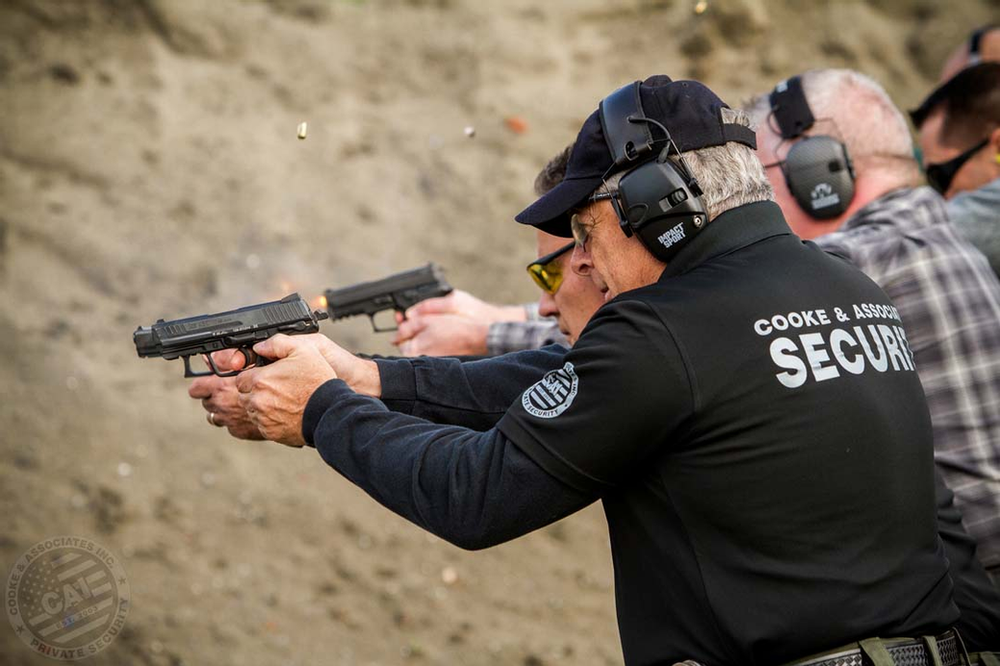
By Garrett Ludke
The original article was published on June 1, 2025 and can be found at ASIS’ Security Management HERE
When most people think of executive protection, they picture a large, suited individual with a bulge on their hip, standing rigidly nearby with a scowl on their face.
But that image is outdated. Today’s protection professionals are far more likely to blend into the background than dominate it. And while many of them are armed, the weapon is seldom used and that is 100 percent by design.
The 99 Percent Rule: The Firearm is a Failsafe, Not a First Option
In modern executive protection (EP), a firearm is not carried as a daily tool, but for scenarios that fall within the narrowest band of likelihood: direct, imminent, and unavoidable threat.
Agents are trained to defuse, de-escalate, and avoid confrontations. The overwhelming majority of their work revolves around advance planning, situational awareness, and seamless logistical execution. Ninety-nine percent of the time, they will never need to draw a weapon.
The presence of a firearm, however, must be supported by exceptional discipline and training. Because once carried, it becomes part of the security equation. Not just tactically, but legally, reputationally, and ethically.
To Arm or Not to Arm: Strategic Considerations
The decision to arm an EP team is never taken lightly. It begins with a threat assessment that examines:
- The principal’s visibility and risk profile
- The operating environment (urban vs. rural, international vs. domestic)
- Public perception and brand considerations
- Legal liabilities and use-of-force thresholds
Take the U.S. state of California, for example, known for both high-profile executives and stringent firearms regulations. Exposed armed EP agents must be properly licensed under Bureau of Security and Investigative Services (BSIS) guidelines, including completion of a 40-hour course and 14 hours of BSIS-certified firearms training.
Required licenses for exposed armed EP agents in California include obtaining a guard card, which consists of eight hours of training prior to the assignment and 32 hours of training within the first six months. This training must include the power to arrest, terrorism awareness, public relations, observation and report writing, and communication.
These agents must also have a firearm permit, which is granted after completing eight hours of classroom instruction on legal issues, liability, moral obligations, and firearm safety. Agents must also complete six hours of live fire qualifications on the type and caliber of firearm to be used while on duty.
Additionally, these agents must undergo an application, live scan fingerprinting, a psychological evaluation, and provide proof of U.S. citizenship or legal status in the United States.
Carrying a concealed weapon (CCW) requires a separate CCW permit issued by local authorities, depending on the role and jurisdiction. The Los Angeles County Sheriff’s Department allows up to three firearms to be listed on a CCW license. Applicants must complete and pass a live-fire course with each firearm to be listed. San Diego County Sherriff, however, requires that applicants must ensure that any firearm listed on their CCW is registered in their name in California. These local conditions underscore the importance of compliance with county specific mandates when applying for or maintaining a CCW.
For corporations and high-net-worth families, this means their security partner must bring not only personnel, but a robust operational infrastructure capable of managing legal compliance across every jurisdiction.
Crossing Jurisdictions: A Complex, Necessary Discipline
One of the most overlooked complexities in executive protection is the challenge of operating armed across state and international borders. Weapons laws vary significantly by jurisdiction. Reciprocity agreements, magazine capacity restrictions, and even the legal definitions of terms such as “concealed” or “loaded” differ from one region to the next.
Effective executive protection programs rely on detailed pre-mission planning and legal coordination. Teams must assess each jurisdiction’s laws, identify restrictions, and determine the most effective and lawful course of action. This often includes working with legal counsel to secure transport approvals, coordinating with local authorities, or engaging vetted local assets when the law prohibits the carriage of weapons. In some environments, teams may deploy non-lethal tools such as expandable batons or OC spray, although these options also require jurisdiction-specific vetting and rigorous training.
Flexibility in these cases is not a compromise, it is a deliberate, strategic decision that ensures mission success while maintaining full legal compliance.
This is best illustrated by two scenarios.
When protecting a principal traveling from San Francisco to major business hubs like New York City or Chicago, the protective team must account for variations in state laws, including licensing requirements and restrictions on magazine capacities. If the threat assessment indicates elevated risks, such as specific threat actors or scheduled public demonstrations, the team may deploy armed agents while securing all necessary permits in advance and coordinating with local security teams to ensure seamless operations from arrival to departure.
For a principal traveling internationally from Los Angeles to London, for instance, the challenges expand further. United Kingdom law prohibits the carriage of firearms by private security personnel. In this instance, the team deploys unarmed, working closely with a vetted and licensed local partner to provide close protection that meets the country’s standards. Throughout the assignment, a dedicated Global Security Operations Center can provide real-time intelligence monitoring and contingency planning, ensuring no lapse in security coverage.
These examples highlight the necessity for protective teams to anticipate complexity, plan for every variable, and adapt without disruption. Operating across jurisdictions requires more than simply navigating legal frameworks, it demands precise coordination, disciplined flexibility, and the ability to deliver certainty in dynamic, often unpredictable environments.
The Glock 9mm: Simplicity, Reliability, Consistency
Among seasoned EP professionals, the Glock 9mm has emerged as a platform of choice. It’s not glamorous. It’s not custom. But its reliability, ease of concealment, and consistent trigger pull make it the go to. The widespread familiarity across military and law enforcement channels makes it the preferred sidearm in most executive protection settings for a reason. EP teams should review local law enforcement sidearms and ammunition to align practices and minimize legal challenges. This is consideration is twofold: One, if it’s passed the rigors of the local law enforcement it should be good enough for you. Two, legally, and in court it will be much more justified if used than your custom painted camouflaged “Dirty Harry” gun, with a punisher etched into it.
For instance, in People v. Alvarez, the defendant, had heavily modified his handgun (adding features like an extended magazine funnel) and loaded it with exotic high-velocity ammunition. During trial, the prosecution highlighted these facts to imply a deadly intent. The state’s expert argued the defendant “turned his sidearm into a more efficient killing machine,” essentially by customizing it and using ammo more lethal than what police carry. A prosecutor memorably quipped that “standard police ammunition was not good enough for this man—he had to have ‘Thermonuclear’ ammo,” suggesting the defendant intended to inflict extreme harm.
Some other potential legal considerations to keep in mind include:
Perception of intent. Using a firearm commonly issued to law enforcement, like a Glock 9mm, may be perceived as a practical and responsible choice, potentially countering arguments that the weapon was selected for intimidation or excessive lethality.
Ammunition choice. Selecting the appropriate ammunition used by local law enforcement, instead of specialized or high-penetration rounds, can further support the notion of responsible firearm use.
Modifications. Avoiding extensive modifications to the firearm can prevent arguments that the weapon was altered to increase lethality, intimidation, or reduce safety.
Standardizing on a single platform also streamlines training, certification, and real-time operational performance. In high-stress moments, familiarity saves seconds and lives. For those who dislike the Glock platform, remember it’s a poor carpenter who blames his tools.
Training: Where the Weapon Truly Lives
Arming an agent is not about handing them a weapon, it is about establishing a standard of discipline, judgment, and responsibility. Firearms qualification is the baseline, not the benchmark. Agents must engage in ongoing firearms training and certification, completed no less than quarterly. This represents the minimum threshold, and agents should be expected to take personal ownership of their readiness beyond this requirement.
Training should encompass:
Firearms handling and proficiency under stress
Threat recognition and pre-attack indicators
Movement, cover, and tactical positioning
De-escalation techniques under pressure
Jurisdiction-specific use-of-force protocols
Physical and mental stress inoculation
Medical and first-aid
The firearm is a tool, integrated into a larger decision-making framework. It is never the focal point. The most capable agents may go an entire career without drawing their weapon. That is not a failure of readiness, it is a demonstration of professionalism, restraint, and superior situational awareness.
Why We Carry, and Why We Don’t Draw
Firearms are part of the executive protection equation, but they are not the defining factor. The true hallmark of a professional is not their ability to shoot, but their ability to recognize when not to. Discretion, preparation, and restraint are the highest forms of readiness.
The firearm remains holstered because the environment has already been shaped to favor safety. That is not luck. It is discipline, planning, and judgment.
That is the true value to the client, a quiet, confident professional whose greatest asset is not the weapon they carry, but the preparation and judgment they bring.
Garrett Ludke, CPP, is the director of strategic development at Cooke & Associates, Inc. He brings more than 20 years of experience leading complex security operations, with a focus on executive protection, risk mitigation, and corporate security strategy. His career includes providing operational support to Fortune 500 companies such as Boeing, Amazon, and Robinhood. Ludke also serves as chair of the ASIS International Puget Sound Chapter, where he supports the advancement of industry best practices and professional development.


